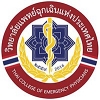Palliative Care in Disaster Situation among Thai Elderly Emergency Department Patient; A Survey of Patient Perspective
Keywords:
disaster, elderly, palliative careAbstract
Introduction: Recently, disasters occur frequently. In disaster situations, the elderly patients are particularly considered in the vulnerable population group. They have chronic diseases as usual. Some of them should receive appropriate palliative care. But the researches on the perspectives of elderly patients about the palliative care during any disaster situations are limited.
Objective: To know the perspectives of Thai elderly patients sent to the emergency room for palliative care during disaster situations. Methods This study was a cross-sectional survey among elderly patients (aged at least 60 years old) visiting emergency department of the Faculty of Medicine Vajira Hospital from August 1 to September 30, 2016.
Results: We surveyed 243 patients. Most of them were female 154 (63.4%). The median age was 72 (IQR 66-81) and the most common underlying diseases were hypertension (148, 60.9%) and diabetes mellitus (108,44.4%). The majority of patients reported that they had much knowledge on both the disaster response (162,66.7%) and high palliative care (147, 60.5%). The first objective of the palliative care was to feel no pain (190,78.0%) while the first medical aid in the palliative treatment assistance was to receive symptomatic treatment whether they are in the normal (208, 86.0%) or disaster situations (209,86.0%) (P=1.00). Most elderly patients asked for some palliative care assistance from hospitals, 223 (92.0%) in normal and 230 (95.0%) disaster situations (P=.065). The end-stage patients wanted to be admitted in hospitals, 126 (52.0%) both in normal and171 (70.0%) and disaster (P=<0.001) situations.
Conclusion: The elderly thought that they had much knowledge on the disaster response and palliative care. The first objective of the palliative care was to feel no pain but the highest need in the palliative treatment assistance was to receive symptomatic treatment. The trend was the same whether they are in normal or disaster situations.
References
Department of Disaster Prevention and Mitigation. Ministry of Interior. Thailand. รายงานผลการศึกษา ทบทวนบทเรียการแก้ไขปัญหาอุทกภัย ปี พ.ศ. 2554. Availlable at: http://www.disaster.go.th/th/download-src.php?did=500. Retrieved December 26, 2016.
โครงการสุขภาพคนไทย. 2560. เสริมพลังกลุ่มเปราะบาง สร้างสังคมที่ไม่ทอดทิ้งกัน. สุขภาพคนไทย 2560 (หน้า 154-80). นครปฐม: สถาบันวิจัยประชากรและสังคม มหาวิทยาลัยมหิดล.
Cherniack EP. The impact of natural disasters on the elderly. Am J Disaster Med. 2008; 3(3):133–9.
Aldrich N, Benson WF. Disaster Preparedness and the Chronic Disease Needs of Vulnerable Older Adults. Prev Chronic Dis. 2008 Jan; 5(1): A27.
Morin VM, Ahmad MM, Warnitchai P. Vulnerability to typhoon harzards in the coastal informal settlements of Metro Manila, the Philippines. Disaster. 2016;40(4):693-719.
Ashkenazi I, Einav S, Olsha O, Turegano-Fuentes F, Krausz MM, Alfici R. The impact of age upon contingency planning for multiple-casualty incidents based on a single center’s experience. Prehosp Disaster Med. 2016; 31(5):492-7.
Lin MR, Huang W, Huang C, Hwang HF, Tsai LW, Chiu YN. The impact of the Chi-Chi earthquake on quality of life among elderly survivors in Taiwan–a before and after study. Qual Life Res. 2002; 11(4):379–88.
Jia Z, Tian W, Liu W, Cao Y, Yan J, Shun Z. Are the elderly more vulnerable to psychological impact of natural disaster? A population-based survey of adult survivors of the 2008 Sichuan earthquake. BMC Public Health. 2010;10(1):1–11.
Gotanda H, Fogel J, Husk G, Levine JM, Peterson M, Baumlin K, et al. Hurricane Sandy: Impact on emergency department and hospital utilization by older adults in lower Manhattan, New York (USA). Prehosp Disaster Med. 2015; 30(5):496-502.
มูลนิธิสถาบันวิจัยและพัฒนาผู้สูงอายุไทย, สถาบันวิจัย ประชากรและสังคม มหาวิทยาลัยมหิดล. สถานการณ์ ผู้สูงอายุไทย พ.ศ. 2559. กรุงเทพ: พริ้นเทอรี่; 2017. p. 13-25.
Department of Health and Human Services, Centers for Disease Control and Prevention. CDC's disaster planning goal: protect vulnerable older adults. Atlanta (GA): U.S. [cited December 1, 2018] Availlable from http://www.cdc.gov/aging/pdf/disaster_planning_goal.pdf.]
World health organization. WHO Definition of Palliative Care. [cited December 1, 2018] Available from : https://www.who.int/cancer/palliative/definition/en.
American psychological association. Fact Sheet on End-of-Life Care. [cited December 1, 2018] Available from: http://www.apa.org/pi/aging/programs/eol/end-of-life-factsheet.aspx.
Matzo M, Powell T, Surbeck J, Erickson CJ. Palliative Care Considerations in Disaster Situations. [cited December 1, 2018] Available from http://asprtracie.s3.amazonaws.com/documents/palliative%20care%20in%20disasters.pdf.
กรมป้องกันและบรรเทาสาธารณภัยกระทรวงมหาดไทย. ความรู้เรื่องภัยพิบัติ [cited December 1, 2018] Available from http://122.155.1.145/cmsdetail.KM-2.182/3498/menu_3389/1433.1/4.
Centers for Disease Control and Prevention. Psychological and emotional effects of the September 11 attacks on the World Trade Center — Connecticut, New Jersey, and New York, 2001. MMWR Morb Mortal Wkly Rep. 2002; 51(35):784–6.
ศูนย์ช่วยเหลือผู้ประสบอุทกภัยด้านสุขภาพจิต. รายงานการประชุมผลกระทบต่อสุขภาพจิต. [cited December 1, 2018] Available at: http://www.mcc-galya.com/userfiles/files/สรุปรายงานการประชุมวันที่%2025%20พฤศจิกายน%2054(1).pdf.
Centers for Disease Control and Prevention. Rapid assessment of the needs and health status of older adults after Hurricane Charley—Charlotte, DeSoto, and Hardee Counties, Florida, August 27-31, 2004. MMWR Morb Mortal Wkly Rep. 2004; 53(36):837–40.
Jhung MA, Shehab N, Rohr-Allegrini C, Pollock DA, Sanchez R, Guerra F, et al. Chronic disease and disasters medication demands of Hurricane Katrina evacuees. Am J Prev Med. 2007; 33(3): 207-10.
Centers for Disease Control and Prevention. Emergency preparedness for people with chronic diseases. [cited December 1, 2018] Available from http://www.cdc.gov/chronicdisease/pdf/infographics/emergency-H.pdf.
The Federal Emergency Management Agency. Individual Disaster Assistance. [cited December 1, 2018] Available from http://www.fema.gov/individual-disaster-assistance.
Pennsylvania Emergency Management Agency. Help Is Available. [cit ed December 1, 2018] Available at: http://www.pema.pa.gov/Documents/1/DR-4289-PR%20b%20Flyer%20508-Help%20is%20Available.pdf.
กรมสุขภาพจิต. สายด่วนสุขภาพจิต. [cited December 1, 2018] Available from https://www.dmh.go.th.
Eilia J, Udita T. Determinants of business continuity management in hospitals. International Journal of Critical Infrastructures (IJCIS). 2017; 13(1):1
Downloads
Published
How to Cite
Issue
Section
Categories
License
บทความที่ได้รับตีพิมพ์ในวารสารเวชศาสตร์ฉุกเฉินแห่งประเทศไทย ถือเป็นเป็นลิขสิทธิ์ของ วิทยาลัยแพทย์เวชศาสตร์ฉุกเฉินแห่งประเทศไทย
กรณีที่บทความได้รับการตีพิมพ์ในวารสารเวชศาสตร์ฉุกเฉินแห่งประเทศไทยแล้ว จะตีพิมพ์ในรูปแบบอิเล็กทรอนิกส์ ไม่มีสำเนาการพิมพ์ภายหลังหนังสือเผยแพร่เรียบร้อยแล้ว ผู้นิพนธ์ไม่สามารถนำบทความดังกล่าวไปนำเสนอหรือตีพิมพ์ในรูปแบบใดๆ ที่อื่นได้ หากมิได้รับคำอนุญาตจากวารสารเวชศาสตร์ฉุกเฉินแห่งประเทศไทย




